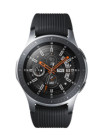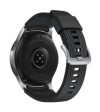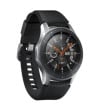Confession time: I'm a born again smartwatch fan. I used to not see the point, and then somehow managed to buy a Samsung Gear S3 Frontier and everything changed. That this thing looked like a watch, had an innovative rotating bezel as an input control mechanism and worked so smoothly with my newly purchased Samsung Galaxy S8+ were the main reasons for that. Having been a very happy smartwatch bunny for the past 18 months or so, I was both interested and annoyed when the next-gen of the Samsung Gear watch family hit the market. I know, I know, there's always going to be something a little better just around the corner and 18 months is a long time in technology. My annoyance was more about the cost, especially as the S3 Frontier wasn't exactly cheap.
Then along came Black Friday which at least got me exploring the possibilities of upgrading to the new Galaxy Watch. I use the term upgrading purposefully as well; that's precisely what I ended up doing. The Black Friday deal, directly through the Samsung Shop online I should add, didn't discount the watch itself which was still £299 for the 46mm Bluetooth (non-4G) version I was interested in. Instead it threw the 'Duo' wireless charger that charges watch and phone together into deal. This was previously only available to pre-orders on launch so a good deal and a value of £89 for good measure. The real deal-sealer for me was the trade-in offered for my S3 Frontier of £100. All of a sudden the Galaxy Watch was in affordable territory at £199 and the debit card came out. So, what did I get for my money?
At first glance, not a lot different to what I got a couple of years ago: The Galaxy Watch looks very similar to the Gear S3 Frontier. Sure, this 46mm model is only available in a rather fetching (to my eye) combination of silver and black whereas the previous model was an all-black affair, but the real differences are mainly under the skin. Apart from the one that is firmly upon of course, by which I mean the heart sensors on the back. These have changed, along with the back itself which is no longer all glass but rather a plastic encased thing. The heart sensors have changed to be more accurate, although some reviewers have complained they don't work as well as the old ones my experience is different. I find that my heart reading can now be done without having to move the watch around, loosen the strap etc., and I'm speaking as a heavily tattooed man whose wrists are far from being nice areas of naked skin for the sensors to sit upon.
I opted for the 46mm version rather than the cheaper and smaller 42mm one because I was perfectly happy with the Gear S3 of the same size (I'm not some Gorilla-wristed freak either, just an average-sized bloke) but mainly for the battery life. The bigger watch comes with a much bigger battery and while I've not got the promised four days out of it, I doubt anyone will, it has added at least a day to what I was getting before. Which means I only need to charge it every other night and it still has a working day left in it spare. I would happily go on a two-day business trip (a three day one at a push) without taking the charger, let's put it that way. To get the full four days you'd need to turn off most of the functionality that you shelled out on a smartwatch for, so I feel the Samsung marketing department is being a little disingenuous here. However, I'm very pleased with the battery longevity of the Galaxy Watch I have to admit.
I loved the look of the Gear S3 Frontier and, as this is the Gear S4 Frontier in all but name, I love the look of the Galaxy Watch as well; heck, I love it even more as the silver and black combo really does look smart. I'm not a fan of SpongeBob on my wrist so the Apple Watch doesn't appeal, a proper circular watch does it for me. The rotating bezel, with a lovely tactile click, more so. Forget all the touchscreen smudges, all the fiddling to hit the small icons and so on. The rotating bezel is a thing of real functional beauty. Believe me, experience it and you won't want to go back to any other type of smartwatch input. There are downsides, of a sort, to this: the rotating bezel is only supported by the Samsung Tizen OS (of which the newest version 4.0 comes with the Galaxy Watch) and not by Android Wear or Apple watchOS. That means no access to Android Wear apps folks, and Samsung watch apps are few and far between. Not much of a real-world hassle for me if I'm honest, as I can still do most everything I want to on a watch (including control my Spotify music streaming from the phone in my pocket and even get mapping directions using Here WeGo on the watch as Google Maps isn't supported.) In short then, I've not found myself thinking 'I wish there was an app for that on my watch' in nearly two years of daily usage of a Tizen OS smartwatch. That it's joined at the hip to my Galaxy S8+ means I have everything I need, thanks very much.
The biggest difference in the two watches has to be the fitness suite, which has been updated for Tizen 4.0 and the Galaxy Watch. There are additional sensors on the back which make all the measurements more accurate in my experience, and the Galaxy Watch is waterproof to 50m so swimming is no longer a non-starter. The Samsung Health app has been updated as well, with more things auto-detected although I still find it gets these wrong - indeed, while typing this review it thought I was cycling. Doh! It does know when I've been walking at a healthy pace for ten minutes and changes to a stopwatch and step recorder type screen. All the steps and health data, including the default heart rate measurements across the day (you can switch them off to save a little battery life if you like) are automatically synced with the smartphone so the health app is always up to date and accurate.



